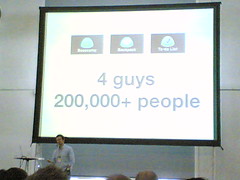Interesting approach to funding
Published July 6th, 2005 edit replace rm!
Probably no more dangerous than Funding by Plastic and probably a lot more fun:
Meador, who is head of operations at ClearContext, and Deva Hazarika, the chief executive officer, have been playing poker in lieu of collecting paychecks for the past year while working to get their three-person company off the ground. After logging 50 or more hours a week at the office, each one spends another 10 to 15 hours, usually on weekends and evenings, at their favorite poker sites—mainly Partypoker.com, Ultimatebet.com and Pokerstars. CNet: High-stakes start-ups
Please don’t do this though unless you know what you’re doing. (That was just my don’t sue me for posting this disclaimer.) If you try it let us know how it goes.
It reminds me of a time when I was so low on cash that I was paying my annual domain name fees “investing” my meager E-Gold account balance on Blackjack at The Gold Casino .
One good thing that semi educated gambling can teach you though is to make calculated bets . This is the same for startups. If you bet all your money/resources in one go you are making a huge bet with a tiny chance of winning.

